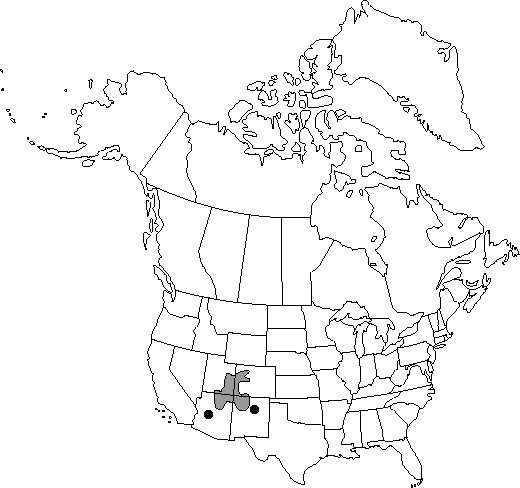Ephedra cutleri
J. Wash. Acad. Sci. 30: 473. 1940.
Shrubs rhizomatous, forming clumps, erect, 0.25–1.5 m, 3–5 m diam. Bark reddish-brown, cracked and irregularly fissured. Branches alternate or whorled, rigid, angle of divergence about 25°. Twigs bright green, becoming yellow-green with age, viscid, ridges between longitudinal grooves papillate; internodes 1–5 cm. Terminal buds conic, 1–3 mm. Leaves opposite, 2–5 mm, connate to 1/4–1/2 their length; bases thickened, brown, persistent; apex setaceous. Pollen cones 2–several at node, obovoid, 4–6 mm, on very short, scaly peduncles (rarely sessile); bracts opposite, 5–9 pairs, light yellow, ovate, 2–4 × 2–3 mm, membranous, slightly connate at base; bracteoles slightly exceeding bracts; sporangiophores 2–4 mm, barely exserted, with 5–7 sessile to short-stalked (less than 1 mm) microsporangia. Seed-cones 2–several at node, obovoid to nearly globose, 7–15 mm, peduncles 5–25 mm, with 1 pair of basal and 1 pair of nearly terminal bracts; bracts opposite, 3 or 4 pairs, ovate, 3–6 × 2–5 mm, membranous, with yellow center and base, margins entire. Seeds 2, ellipsoid, 5–8 × 2–4 mm, brown to chestnut, smooth.
Phenology: Coning late winter–midspring (Mar–May).
Habitat: Dry, flat, sandy areas, occasionally on rocky slopes
Elevation: 1400–2300 m
Distribution

Ariz., Colo., N.Mex., Utah.
Discussion
The hybrid Ephedra × arenicola is discussed under E. torreyana.
Selected References
None.
Lower Taxa
"/4-1/2" is not declared as a valid unit of measurement for this property.